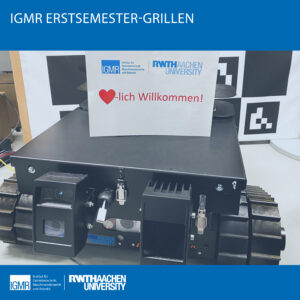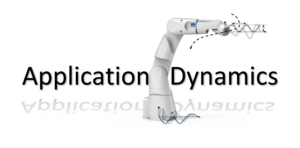Developments with Trapo GmbH
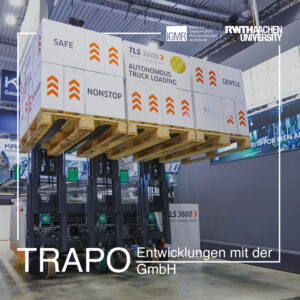
The IGMR – RWTH Aachen supports Trapo GmbH in the further development and integration of trajectory planning and trajectory execution algorithms for the new Trapo Loading System robot. Compared to the old TLS, the navigation of the new TLS is realized with the MoveBase Framework of the Robot Operating System (ROS). For this purpose, together with Trapo GmbH, we have created a special configuration for car-like structure for the local MoveBase Planner. The new TLS was last presented at the LogiMat trade fair.
Contact:
Daniel Gossen
Project launch IIDEA – Inclusion and integration through cobots on the labor market

In April, the innovative project “IIDEA – Inclusion and integration through cobots in the first labor market” was launched, which aims to empower the inclusion and integration of severely disabled people in the first labor market through collaborative robotics.
The deployment of cobots makes it possible to create new jobs and forms of work that satisfy the individual needs of severely disabled people. These new forms of work are not being established on the margins but at the heart of digitization and Industry 4.0.
In a rapidly changing world, we must focus on the needs of all people and ensure that everyone can reach their full potential. The IIDEA project is an important step towards an inclusive and inclusive society and economy.
For more information about the project, please visit the project profile. If you have any further questions, please feel free to contact our staff: iidea@igmr.rwth-aachen.de.
Contacts:
Prof. Mathias Hüsing
Carlo Weidemann
Sophie-Charlotte Keunecke
Elodie Hüsing
Christina Jansen
Welcoming the new Master’s first semester students
The Institute of Transmission Technology, Machine Dynamics and Robotics welcomes all new first-semester Master’s students!
The summer semester started on 03.04.2023 and with it the Master’s program for many first-semester students. At a welcome barbecue organized by the Mechanical Engineering student council, we were able to introduce our institute and talk to students.
Sophie Charlotte Keunecke, Nils Brückmann, Vincent Brünjes and Thomas Knobloch welcomed the new Master’s students from the Faculty of Mechanical Engineering at the IGMR. This allowed the students to make their first contacts with the institutes and also get to know various projects. A special highlight was the presentation of the Robot Companion by Maximilian Hilger!
We would like to thank the Mechanical Engineering student council for this great offer and your immense commitment.
We wish all new first-year students all the best for their studies and an unforgettable time at RWTH and the Faculty of Mechanical Engineering.
Contacts:
Sophie-Charlotte Keunecke
Nils Brückmann
Vincent Brünjes
Thomas Knobloch
Successful workshops with the Technical University of Liberec
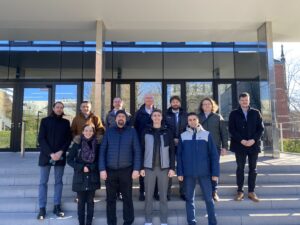
Four different institutes of the Technical University of Liberec introduced us to their fascinating projects and interesting presentations before we worked out common research interests in smaller workshops.
The Technical University of Liberec and the IGMR can already look back on many years of joint exchange and close cooperation; the restrictions imposed by the pandemic have not weakened this, but have severely limited it.
Therefore we are pleased to be able to strengthen our cooperation with new, joint research interests in the future.
Contact: Sophie Charlotte Keunecke
Interactive learning with ROS: The new course in RWTHJuypter
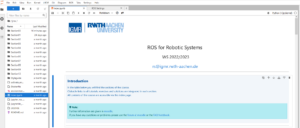
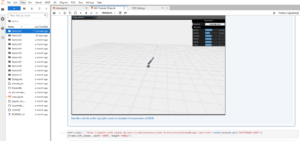
We are pleased to present our latest ROS course, which is integrated as JupyterHub under RWTHJupyter. This course offers an interactive way to learn and deepen the basics of ROS (Robot Operating System).
ROS is an open source framework that allows developers to simplify the control of robots and their sensors. It provides a set of tools and libraries that make it possible to simplify the communication between the different components of a robot and speed up the development of applications.
Our course covers the main topics required to work with ROS. These include using ROS nodes, topics, services and actions, using ROS libraries such as tf (transform library) and moveit (motion planning library), and developing your own ROS packages. Working with different robot platforms is also covered.
Special emphasis is placed on the use of Jupyter notebooks to make the course interactive and vivid. This allows students to complete the examples and exercises directly in the course environment and see the results immediately.
We would like to thank Quantstack for their support in developing the course and their developments on JupyROS. By using Jupyter notebooks and JupyROS, we have been able to create an intuitive and user-friendly environment that makes learning ROS quick and easy.
We hope that our ROS course will be useful for both beginners and advanced developers and look forward to welcoming many participants.
Contact: Markus Schmitz
Review Summerschools ROBO and ROCNI 2022

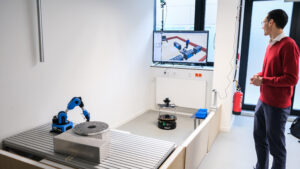
The Summerschool serves to educate and deepen the knowledge of interested students. The Summerschool ROBO and ROCNI are offered by the International Academy (IntAc) and conducted by the Institute of Mechanism Theory, Machine Dynamics and Robotics (IGMR) at RWTH Aachen University. The theoretical basics are esxtended by the practical application of simulations and on the real robot in the laboratory of the IGMR.
Contact:
German Robot System Integration Championship 2022
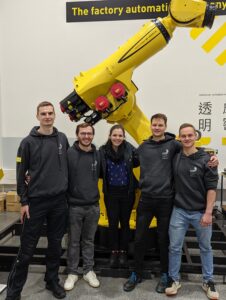
Once again IGMR successfully participated in the German Championship (formerly the Olympics) in Robot System Integration at FANUC Germany!
This year’s task was the variable loading and palletising of boxes. In addition to the independent design of the entire cell, both real and virtual, the implementation also included the digital drawing of components, the setting of safety functions, error detection, user friendliness and instructions, as well as the integration of sensors, actuators and cameras.
Simon Strauch and Florian Menz competed under the team name “IGMR“, while Frederick van Kerkom and Sebastian Polzin took part as the “RWTH“ team. They were accompanied by former participant Sophie Charlotte Keunecke as their coach.
The four students have been working independently with the FANUC Education Cell in the IGMR in their free time over the past few months, learning TP programming and simulation in RoboGuide. The effort was worth it!
Team IGMR presented a very impressive real and virtual Cell installation, implementing every menu option for customer convenience and error handling.
Team RWTH achieved the fastest lap times in both timings with 57 seconds and shone with a very detailed simulation and documentation. We are very proud of all four participants for their great performance!
A special thanks to FANUC Germany for the great implementation and the exceptional cooperation.
The FANUC Education Cell is an essential part of the practical teaching of robotics and offers students the opportunity to try out the handling of industrial robots and the use of frames (coordinate systems) and to carry out or verify their own experiments and measurements.
Contact: Sophie Charlotte Keunecke
Presentation of the “ErgoFli” project at the KT Colloquium 2022

The aim of the ZIM-funded project “ErgoFli” is to develop an intelligent, semi-automatic tiling aid. Its intuitive user interface, automated handling of tiles and tile adhesive, and intelligent control system are expected to reduce non-ergonomic postures by up to 66%. The ErgoFli can be moved with a motorised drive and uses linear laying kinematics to lay tiles without direct wall contact using the buttering-floating method. Tiles in two formats, 30x60 cm or 60x60 cm, can be laid in a cross bond. The robot is equipped with a tile and tile adhesive reservoir so that it can be used for at least 30 minutes without refilling and can lay 12 m2 per hour while maintaining the required standard flatness tolerances.
Using a digital twin, an early prototype has already been tested in various scenarios. While the prototype is being designed in standard CAD software, the actual model is being integrated into the Gazebo simulation environment in parallel. This enables continuous integration and testing of control system software packages in application-related scenarios. For example, real test data can be transferred to the digital twin via a closed-loop simulation. The three laser profile sensors of the tile gripper are attached to a prototype gripper and mounted on a UR10 robot arm. The measured values from the sensors can then be transferred to the digital twin in the simulation, despite the different kinematics. In this way, the position control of the gripper can be integrated into the overall system at an early stage by measuring the joint widths.
Contacts:
Jan Wiartalla
Marius Gürtler
Automatic Robot-Guided Form Scan and Coating
In this project, the forms are detected and their edges are realized by a laser scanner mounted on the end effector of the robot. The collected data are synchronized and filtered, and a suitable trajectory is created for coating the inner surface of the forms. Several variables, such as the speed of the nozzle, distances and gaps, the size of the nozzle and the outlier for a homogeneous coating can be selected during the trajectory planning.
Motivation
The project was initiated with the motivation to increase flexibility in scanning and coating various molds.
Method
In the context of this project, synchronization is required between three systems
The sensor software, which is responsible for the acquisition of the data (synchronized with movement of the robot).
The program, which is responsible for post-processing the data and calculating the trajectories for the robot.
The Robot control system, which receives the information of the trajectory and executes it immediately.
Partner
International Partners in Glass Research (IPGR) e.V.
Contact: Markus Schmitz
Watch the video on our Youtube Channel: here.
Music: Corbyn Kites – Blurry Vision


